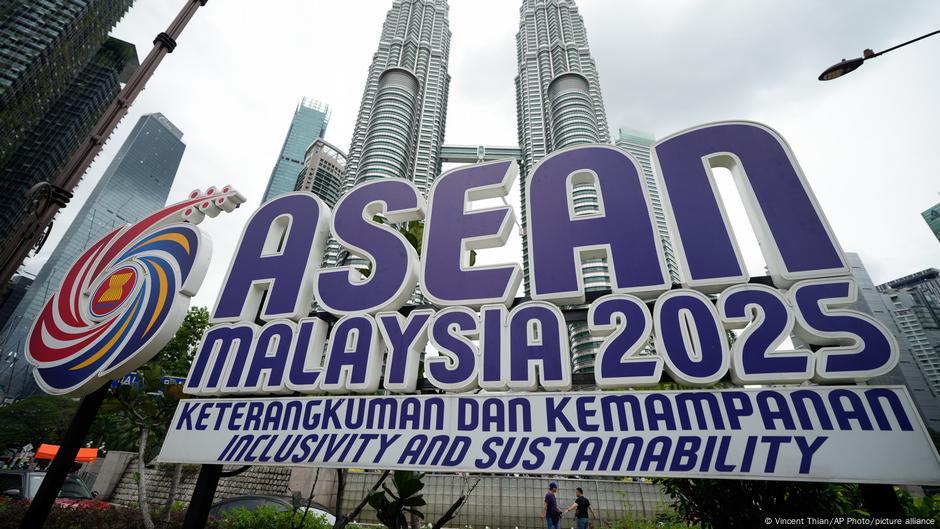At the summit of the , there will be plenty to discuss. On the agenda at the three-day meeting, which begins Sunday in the Malaysian capital, Kuala Lumpur, will be regional economic integration, and digital developments as well as peace, security and regional stability.
More than 30 heads of state and government from the 10 member states of the association, commonly referred to as , are invited. Among the invitees from outside the bloc is US President Donald Trump.
Trump primarily wants to attend a ceremony where sign a recently negotiated peace settlement. The settlement was reached after five days of fighting triggered by border disputes partially due to pressure from Trump, who threatened economic consequences if the two countries didn’t resolve the issue.
The event showed just how much influence the US has in the Asia Pacific region. It’s significant because of the growing rivalry between the US and China in this region.
Part of the geopolitical competition between the two superpowers involves Taiwan: believes the island belongs to it but the US supports the status quo with as a self-governing democracy.
Both superpowers are also wrangling over the existing order in the South China Sea. The tensions center around overlapping claims by China, Taiwan, and Southeast Asian nations like the Philippines, Vietnam, and Malaysia over the resource-rich waters. China’s expansive “nine-dash line” claim encompassessing about 90% of the sea violates international law and the other nations’ exclusive economic zones.
Forced to choose a side
There are also growing trade tensions between China and the US and that’s exacerbating the two nations’ rivalry in Southeast Asia further, says Felix Heiduk, head of the Asia research division at the German Institute for International and Security Affairs. That means that, apart from the official agenda, there’s bound to be a lot of talk about US-China tensions and the difficult position that these tensions put ASEAN countries in. Many are being pressured to choose between one or the other superpower.
That’s true, Heiduk confirms, especially when it comes to sectors like security, trade and technology. “Ultimately, this logic boils down to a kind of zero-sum game. You’re supposed to be in one camp or the other,” he said.
ASEAN countries are
It is also becoming increasingly difficult for either the US or China to persuade them to take a side. An analysis by the magazine, The Diplomat, suggests that many politicians in the region are dismayed by Trump’s tariff policies. These have impacted the US’ closer allies in the region as well as those more distant.
Given current sensitivities over the control of various parts of the South China Sea, ASEAN states with a maritime boundary there are particularly touchy about bold claims of territorial dominance. They have watched Trump demand control over the Panama Canal, Greenland and Canada with astonishment and concern, fearing that if the inviolability of national borders can be called into question like this by the US, then it will encourage China to make similar claims in their region.
According to The Diplomat, this has led to a different perception of the US in Southeast Asia.
US not seen as reliable partner
A number of ASEAN countries no longer see the US as a reliable partner — especially in the face of increasing Chinese belligerence in the region, says Andreas Ufen, a senior expert at the German Institute for Global and Area Studies, or GIGA, in Hamburg.
According to a report on the East Asia Forum, an international forum for policy on the region, China is laying claim to external territories and building artificial islands for military purposes, for example near and on the Spratly and Paracel islands. The report also says China is developing resources in disputed territories and interfering with maritime transport by doing so.
ASEAN states are reacting to Chinese aggressiveness in different ways. Some of the economically weaker ones have little choice but to put up with it.
“Myanmar, Cambodia and Laos, for example, are closely aligned with China, both economically and in terms of security and defense policy,” Heiduk said. “Along with that comes the fact that they don’t have close defense and security relationships with the US.”
A difficult balancing act
The larger and wealthier countries try to , striving to cooperate with both countries as much as possible.
For example, the Philippines cooperates closely with the US on defense and security, with the two nations signing a mutual defense treaty back in 1951. This has become increasingly important given China’s growing military presence in the South China Sea, Heiduk explains.
“However that military cooperation doesn’t stop the Philippines from maintaining ,” Heiduk noted. “China is one of the Philippines’ three most important trading partners and also a key investor there.”
Indonesia is also trying to avoid picking a side, GIGA analyst Ufen adds.
“Indonesia sometimes cooperates with China and sometimes with the US,” he notes. In terms of defense and weapons procurement, Indonesia does tend to orient itself towards Western partners though. “Because if an armed conflict ever did arise, it’s most likely to be in the South China Sea with China,” Ufen explains. The US even conducts major military exercises with Indonesia.
But none of that stops Indonesia from seeking economic ties with China too. “Economically, Indonesia and China work closely together,” Ufen says.
This article was originally written in German.
The post ASEAN summit: Torn between China and the US appeared first on Deutsche Welle.




